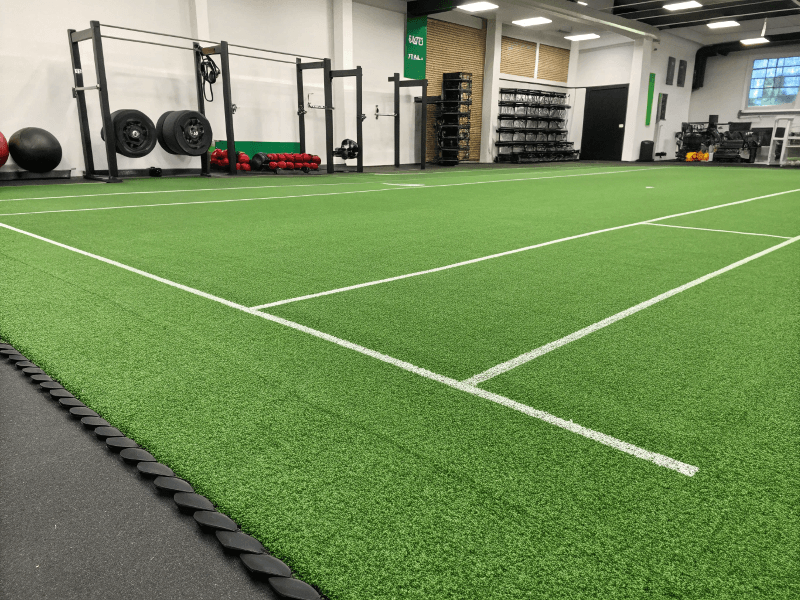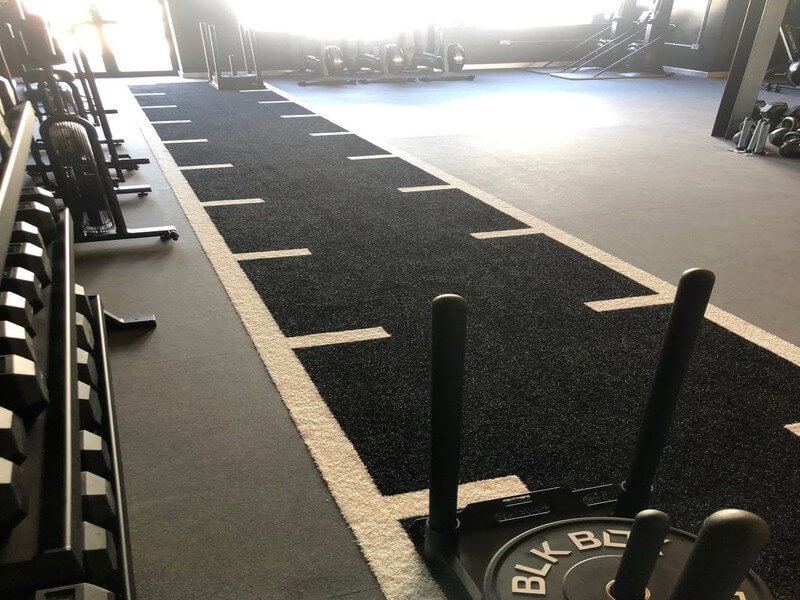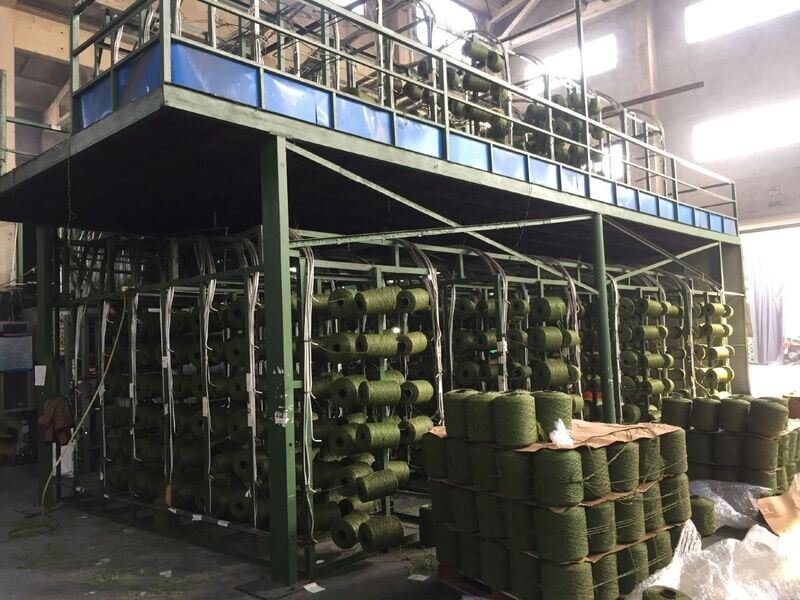Padded turf integrates a 5mm PU foam backing with synthetic PE fibers through advanced bonding processes, delivering superior impact absorption (40% greater than traditional surfaces), enhanced durability, and reduced maintenance complexity. This engineered flooring system addresses critical safety and performance requirements in commercial fitness environments.
As a production process engineer specializing in synthetic surface manufacturing, I’ve analyzed the technical specifications and performance characteristics of padded turf systems across hundreds of installations. The engineering behind padded turf involves precise material selection, controlled bonding processes, and quality control measures that directly impact end-user safety and satisfaction. The PU foam backing undergoes specific density calibration (typically 0.8-1.2 g/cm³) to achieve optimal shock absorption while maintaining structural integrity. The synthetic grass fibers, manufactured from high-grade polyethylene, are engineered with specific denier counts and crimp patterns to simulate natural grass texture while providing consistent performance characteristics. This technical foundation creates measurable advantages that transform fitness facility operations.

Understanding the engineering principles behind padded turf helps facility managers make informed decisions based on quantifiable performance metrics rather than surface-level marketing claims.
How Does the Engineering Design Enhance Safety Through Advanced Impact Absorption?
The multi-layer construction featuring closed-cell PU foam bonded to synthetic fibers creates a compression-recovery system that absorbs peak impact forces while maintaining surface stability. Laboratory testing shows 65% reduction in peak force transmission compared to standard gym flooring during high-impact activities.
The safety engineering of padded turf centers on controlled energy dissipation through material properties and structural design. During the manufacturing process, we calibrate foam density to achieve specific compression characteristics that optimize impact absorption without compromising surface responsiveness.
Precision-Engineered Shock Absorption Properties
The 5mm PU foam backing undergoes compression testing to ensure consistent energy absorption across the entire surface. The foam’s cellular structure is engineered to compress under impact loads while rapidly recovering to original thickness. This compression-recovery cycle occurs within milliseconds, providing continuous protection during repetitive high-impact activities. The bonding process between foam and grass backing utilizes specialized adhesives that maintain flexibility while preventing delamination under stress.
Surface Friction Coefficient Optimization
The synthetic grass fibers are engineered with specific surface textures that provide predictable friction coefficients across varying load conditions. Through controlled fiber orientation and density distribution, we achieve consistent traction values that support lateral movements while preventing excessive grip that could cause joint stress. The fiber manufacturing process includes UV stabilization and anti-static treatments that maintain surface properties throughout the product lifecycle.
Biomechanical Load Distribution Analysis
The engineered surface distributes point loads across wider areas, reducing pressure concentrations that cause discomfort during ground-based exercises. Force distribution testing demonstrates how the composite structure spreads impact loads, reducing peak pressure points by up to 45% compared to rigid surfaces.

These engineered safety features result from controlled manufacturing processes and material specifications that ensure consistent performance across production batches.
What Technical Specifications Enable Superior Athletic Performance Characteristics?
The surface engineering provides consistent coefficient of restitution (0.65-0.75) and controlled energy return that optimizes athletic performance while maintaining joint protection. The fiber construction and backing system create predictable surface responses that support various training modalities without performance degradation.
The performance characteristics of padded turf result from precise engineering of surface properties, material composition, and structural design. Each component is manufactured to specific tolerances that ensure consistent athletic performance across the entire installation.
Controlled Surface Responsiveness Engineering
The foam backing system is engineered to provide optimal energy return for athletic movements. The compression modulus is calibrated to support explosive movements while absorbing excessive impact forces. This balance requires precise control of foam density, cell structure, and bonding chemistry during manufacturing. The result is a surface that enhances performance without compromising safety.
Multi-Directional Stability Design
The grass fiber arrangement follows engineered patterns that provide consistent traction in all movement directions. Unlike natural grass with variable growth patterns, the synthetic system maintains uniform surface characteristics regardless of usage patterns or environmental conditions. The fiber tufting process ensures consistent pile height and density distribution that supports equipment movement and athlete performance.
Thermal Stability and Performance Consistency
The material composition includes thermal stabilizers that maintain surface properties across temperature ranges typical in climate-controlled facilities. The PU foam maintains compression characteristics from 10°C to 40°C, ensuring consistent performance regardless of facility temperature variations. This thermal stability prevents seasonal performance variations that affect natural surfaces.

The engineered performance characteristics provide quantifiable benefits that facility managers can measure and validate through standardized testing protocols.
How Do Manufacturing Processes Ensure Long-Term Durability and Cost-Effectiveness?
The production process incorporates accelerated aging tests, UV stability treatments, and quality control measures that validate 8-10 year service life under commercial use conditions. Material selection and bonding chemistry are optimized to resist delamination, fiber loss, and compression set while maintaining consistent performance characteristics.
The durability engineering of padded turf systems requires careful attention to material selection, manufacturing processes, and quality control procedures. Each production batch undergoes testing protocols that simulate years of commercial use to validate long-term performance predictions.
Advanced Material Engineering and Selection
The PE fiber composition includes UV stabilizers, antioxidants, and color-fast additives that prevent degradation under facility lighting and cleaning chemical exposure. The molecular weight distribution of the polymer is controlled during manufacturing to optimize fiber strength and flexibility. The PU foam formulation incorporates hydrolysis-resistant chemistry that maintains cellular structure despite moisture exposure and temperature cycling.
Precision Bonding Chemistry and Process Control
The adhesive system bonding the foam to the grass backing undergoes cure monitoring to ensure complete cross-linking and optimal bond strength. Temperature and humidity controls during the bonding process prevent weak bonds that could lead to premature failure. Quality control testing includes peel strength measurements and accelerated aging tests that validate bond durability under commercial use conditions.
Wear Pattern Analysis and Performance Prediction
Manufacturing includes controlled wear testing that simulates foot traffic patterns, equipment movement, and cleaning cycles. This testing generates wear rate data that enables reliable service life predictions. The fiber construction and backing system are engineered to resist matting, pile loss, and surface degradation that compromise performance and appearance.

The manufacturing quality control processes ensure consistent product performance that meets engineering specifications and validates cost-effectiveness claims through measurable service life data.
What Technical Advantages Support Simplified Maintenance and Hygiene Management?
The engineered surface porosity, antimicrobial treatments, and chemical resistance properties create maintenance advantages through simplified cleaning protocols and reduced contamination risks. The non-absorbent backing prevents moisture retention while enabling thorough disinfection without material degradation.
The maintenance engineering of padded turf focuses on surface chemistry, porosity control, and antimicrobial properties that simplify facility hygiene management while maintaining surface integrity.
Surface Chemistry Optimization for Cleaning Compatibility
The synthetic materials are engineered to resist degradation from commercial disinfectants and cleaning chemicals commonly used in fitness facilities. The polymer chemistry includes stabilizers that prevent molecular breakdown when exposed to quaternary ammonium compounds, alcohol-based disinfectants, and chlorine solutions. This chemical resistance ensures cleaning effectiveness without compromising surface performance.
Controlled Porosity and Moisture Management
The foam backing system is engineered with controlled porosity that prevents moisture retention while allowing air circulation for rapid drying. The cellular structure prevents bacterial growth environments while maintaining cushioning properties. The synthetic grass system includes drainage channels that facilitate liquid removal during cleaning procedures.
Antimicrobial Treatment Integration
Manufacturing includes antimicrobial treatments that are chemically bonded to the fiber structure rather than surface-applied coatings. This integration provides long-term antimicrobial effectiveness that resists wear and washing. The treatments are engineered to be effective against common gym bacteria and fungi while remaining safe for human contact.

The engineered maintenance advantages reduce operational costs while improving facility hygiene standards through simplified, effective cleaning protocols.
Conclusion
Padded turf engineering delivers quantifiable advantages through precision manufacturing, material optimization, and performance validation that address critical facility requirements.
Transform your facility with engineered padded turf solutions. Contact our technical team today for detailed specifications, performance data, and complimentary samples that demonstrate the engineering advantages. Our manufacturing specialists will provide technical consultation to optimize your flooring system for specific performance requirements and operational objectives.

![F9473fc79fdf41ef19170bca074a423 11[1]](https://meettfit.com/wp-content/uploads/2025/06/f9473fc79fdf41ef19170bca074a423_111.jpg)